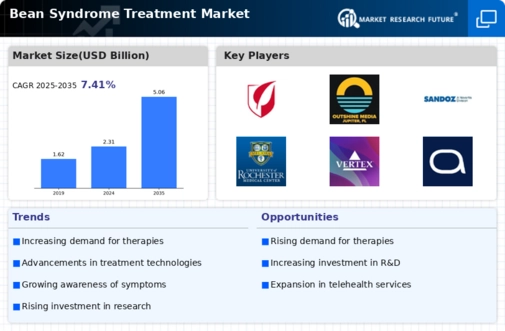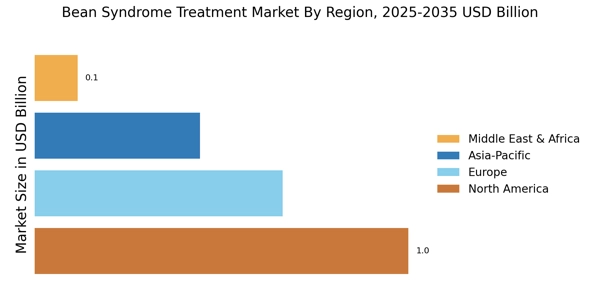Growing Patient Advocacy
The emergence of patient advocacy groups is influencing the Bean Syndrome Treatment Market Industry positively. These organizations play a vital role in raising awareness about Bean Syndrome, educating patients and healthcare providers, and advocating for better treatment options. As these groups gain traction, they are likely to mobilize resources and support for research initiatives, which can lead to the development of new therapies. Furthermore, patient advocacy efforts can enhance the visibility of Bean Syndrome, prompting healthcare systems to prioritize its treatment. This increased focus may result in improved access to care and resources for affected individuals. Consequently, the activities of patient advocacy groups are expected to contribute to the growth of the Bean Syndrome Treatment Market Industry by fostering a more informed and engaged patient population.
Increased Research Funding
The allocation of increased research funding is a significant driver for the Bean Syndrome Treatment Market Industry. Governments and private organizations are recognizing the need for more comprehensive research into rare diseases, including Bean Syndrome. This trend is evidenced by the rise in grants and funding opportunities aimed at understanding the underlying mechanisms of the syndrome and developing effective treatments. For example, recent initiatives have led to a surge in clinical trials focused on novel therapeutic approaches, which could potentially transform the treatment landscape. As more resources are dedicated to research, the likelihood of discovering new treatment options increases, thereby enhancing the Bean Syndrome Treatment Market Industry. This influx of funding not only supports scientific inquiry but also fosters collaboration among researchers, healthcare providers, and pharmaceutical companies, further driving innovation.
Advancements in Medical Technology
Technological advancements play a crucial role in shaping the Bean Syndrome Treatment Market Industry. Innovations in medical technology, such as telemedicine, artificial intelligence, and advanced diagnostic tools, are enhancing the ability to diagnose and treat Bean Syndrome effectively. For instance, the integration of AI in diagnostic processes allows for quicker and more accurate identification of the syndrome, which is essential for timely intervention. Moreover, the development of minimally invasive treatment options is likely to improve patient outcomes and satisfaction. As these technologies continue to evolve, they may lead to the emergence of new treatment modalities, thereby expanding the market landscape. The ongoing investment in medical technology is expected to drive growth within the Bean Syndrome Treatment Market Industry, as healthcare providers seek to adopt the latest advancements to improve patient care.
Rising Prevalence of Bean Syndrome
The increasing incidence of Bean Syndrome is a primary driver for the Bean Syndrome Treatment Market Industry. Recent studies indicate that the prevalence of this condition has been on the rise, with estimates suggesting that it affects approximately 1 in 10,000 individuals. This growing patient population necessitates the development and availability of effective treatment options. As awareness of Bean Syndrome expands among healthcare professionals and the general public, more individuals are likely to seek diagnosis and treatment. Consequently, this trend is expected to stimulate demand for innovative therapies and interventions, thereby propelling the Bean Syndrome Treatment Market Industry forward. Furthermore, the rising prevalence may lead to increased funding for research and development, fostering advancements in treatment methodologies.
Regulatory Support for Treatment Development
Regulatory support for the development of treatments is a critical driver for the Bean Syndrome Treatment Market Industry. Regulatory agencies are increasingly recognizing the need for expedited pathways for the approval of therapies targeting rare diseases, including Bean Syndrome. This shift in regulatory focus is likely to encourage pharmaceutical companies to invest in research and development for new treatment options. For instance, the introduction of orphan drug designations can provide incentives such as tax credits and market exclusivity, making it more appealing for companies to pursue treatments for Bean Syndrome. As regulatory frameworks evolve to support innovation, the Bean Syndrome Treatment Market Industry is expected to benefit from a more favorable environment for the development and commercialization of new therapies.


















Leave a Comment